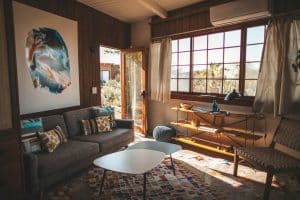 “My house reminds me of Brasilia! I live there, but it isn’t a home!”
“My house reminds me of Brasilia! I live there, but it isn’t a home!”
Those were the words of Fernanda, a retired immigrant from Brazil who lives in Oakland, when asked about her home. She wanted to age in place and found a home that had been retrofitted for older adults, but it just wasn’t right. When asked about the comparison, she talked about how the capital city, Brasilia, was designed from scratch to be “perfect,” but forgot to take into account how people lived. The streets were too wide, there was nothing to do in the residential areas, and there was no street life.
“Everything was clean and nice,” she said, “but there was no life. And that’s how I feel about my home. There are ramps and lights, but I can’t live there. It doesn’t feel human.”
That’s a terrible problem that many people who retrofit a home to age in place or move to an area designed for older adults face: a design to make life easier but that neglects the actual life. Aging at home should keep the “home” part in mind, and it should be livable and enjoyable. It should facilitate actual living and not just aging.
Where Urban Planning Meets Conscious Design
Outside of a home, there are a few necessary steps that will make aging in place easier. Cities and other municipal bodies have the ability to make life easier for older adults by putting in place regulations that make getting around easier.
Cities can incorporate smart technology to enhance ride-sharing capabilities and Internet of Things-connected telehealth services. They can make sure every street is compliant with requirements of the Americans with Disabilities Act, and zone new development to ensure that stores don’t have quarter-mile parking lots that make getting in the store an ordeal for people relying on public transportation. They can introduce clean public facilities, as well as more areas to stop to rest when walking.
This is happening around the world, with cities like London and Milan carving out age-friendly areas for older adults. Berlin wants to be 100% age-friendly by 2020. In the United States, AARP is encouraging cities to become more conscious of older adults through groups, education, and voluntary legislation.
What these efforts have in common is that they are making cities more livable. It isn’t just function, but an actual conscious effort to make sure that older adults aren’t cooped up, trapped away from a world that only caters to drivers and the physically fit.
Their homes should have the same sense of purpose.
Aging in Place Design Checklist: Six Requirements for Living at Home
So what do we mean by living at home? We mean a home that has the convenience and safety of a home retrofit, but that isn’t beset by dull gray functionality. There are six things to keep in mind:
- Ease and accessibility: As we said, the home shouldn’t be purely functional, but you still want it to be safe, accessible, and convenient for older adults. It needs to be safe for aging in place or everything else on this list matters that much less. There are simple and effective ways to retrofit a home, depending on the individual needs of you or your older loved one.
- Proximity to options: One thing Fernanda always said about Brasilia (where she worked soon after it was built in the 1950s) is that the stores and the nightlife options were nowhere near the residential sector. There was no street life and getting anywhere meant long drives. So they were trapped. That’s not what you want to happen with a home for aging adults. If you are buying a home or moving, the house should have positive walkability scores and be convenient to public transportation. Ideally, there should be a community of older adults but not exclusively. As in everything in real estate, location is key.
- Views: What do you see when you look out your window? A bucolic treescape? A bustling city street? A yard or a garden? An area where kids are playing? The views from the windows should be stimulating and interesting. There should be natural light. Many older adults still spend a lot of time at home, but that doesn’t mean they should be entirely shut off from the outside.
- Access to outdoors: This is part of accessibility, but we often neglect the outside of a home. It should be easy to step or roll into the yard to get some fresh air. To go outside just to feel the sun on your face or the softening breeze of a spring dawn. Going outside shouldn’t just be for shopping trips or doctor’s visits. It should be easy to just get outside when the outside calls.
- Technology: One of the more difficult parts of aging at home is the constant cycle of trips to the doctor for checkups or routine procedures. It is time-consuming and frustrating. Where there aren’t medical professionals there is the need for monitoring, which means having to arrange a schedule around a caregiver or nurse. But with smart technology and telehealth, that can be avoided. Biometric measures can be taken and transmitted instantly, obviating the need for lengthy exams. That frees up time. A connected home means being able to connect with everything else.
- Stimulating interiors: What is on your walls? What do you see when you move around your house? Is it uplifting? Is it filled with beauty? And does it then fill you with beauty? It should. An interior should be decorated to move and inspire, according to individual tastes. Never think a home needs to be bland because there are no-slip pads in the shower and a chair lift.
That’s the point. The home isn’t just for aging, it is for living. We need to remember that aging is just a part of life, and it isn’t walled off from the rest of our lived experiences. We all feel that our homes, when we are younger, should be places of activity and beauty, a reflection of who we are. It’s the same thing when we are older.
We know there must be compromises to necessities. You might not like a ramp, but if it is needed, that’s really no choice at all. But you don’t have to compromise to some misplaced notion that a functional house can’t be filled with the sounds of life. They should be. As Fernanda told me when she found a home that satisfied her, “I have a door that is open whenever I want.”
Whether you’re looking for home care services or resources to age in place comfortably, Institute on Aging is here to help. We provide older adults, their caregivers, and their families with programs to help make life easier. Contact us today to learn more.







